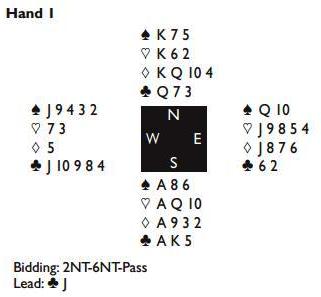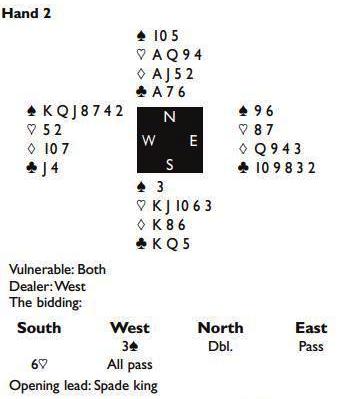Source: ecatsbridge.com
Bridge is a game of deduction, judgment and memory. Memory improves with practice, judgment improves if you learn from experience. But deduction is the key skill you need to have. It is difficult to teach but the golden rule is: never let the brain go to sleep! Your brain needs training, and the best exercise is to try continually to deduce the opponents’ distribution. This is particularly useful in defence, but also in changing plans when declarer.
1. The bidding
The longer the auction the more information you have. If you are passing throughout, do not go to sleep. Try to picture their shape. If you are on lead, think about the shape of dummy e.g. playing weak notrump and 4-card majors they have an unopposed auction starting on your left:
| 1 |
1 |
| 2 |
2 |
| 3 |
4 |
| All pass |
Dummy should be 3541 or 2542 in shape and they are unlikely to have ten easy winners. A trump lead may well stop declarer ruffing a club. During the play, if you discover declarer has only five trumps, he is unlikely to have more than one heart etc.
2. The play
The key clues to shape are:
(a) Someone shows out of a suit! It may seem obvious to say work out the implications for the fourth hand, but the fact is the majority of players do not bother until later in the hand when they believe they have a problem. By then it is often too late. You must get into the habit, on EVERY deal, however dull, of working out the missing hands.
The player who asks at the end of play:“How many clubs did you have?” proves he is not doing this work.
(b) Defensive signals: These can be used equally by defender’s partner and declarer so beware if the signal is going to be more help to declarer than partner. It is standard to give count:
(1) when declarer plays a suit;
(2) when attitude is known;
(3) when following suit after giving attitude signal on the first trick.
(c) Inferences from the actions of the other two players: These may be very complex, but simple ones occur on every deal – so practice with the easy ones. For example: in a spade contract declarer cashes the ace of clubs, crosses to dummy with a trump to the ace (both defenders following small) and then plays the king of clubs from dummy. Inference: declarer is void of clubs or he would have played the trump BEFORE the ace of clubs. You do not have to wait for declarer to show out to give partner a signal. Equally in a trump contract when declarer wins the opening lead and starts by cashing the ace and king of a six-card suit I dummy, you can be almost sure that he has a singleton in hand and is taking a critical discard. Do not automatically tell partner how many cards you have in that suit – in half a trick’s time he will SEE declarer show out and know for himself. Concentrate on misleading declarer or giving suit preference as appropriate.
(d) “Compulsory” assumptions based on the aim of defeating the contract. These are very common in team bridge e.g.“if declarer has five diamonds he has his contract so I must assume he has only four, in which case he must have at least x clubs.”
Practice Hands
As declarer you should duck a spade immediately to get the count. If you cash clubs, East shows out; if you cash hearts, West shows out; but if you also get to play three spades, East shows out again and only he can have four diamonds. The key, though, is that to play three rounds of spades safely you need to duck either the first or second round of the suit.
Declarer wins the lead draws trumps, and before playing diamonds cashes the three top clubs. When West shows up with precisely two clubs, along with two hearts and seven spades, he has only two diamonds. So there is no point in taking the diamond finesse – if the queen is right it will pop up immediately. So declarer cashes two diamonds and exits with a spade. The effect of that is to endplay West to lead spades and give declarer a ruff and discard. Had West shown up with three diamonds, declarer would simply take the diamond finesse and hope for the best.
South reaches Six Spades and West leads the heart king. South wins, draws trumps in two rounds, eliminates the clubs by playing the ace and king and ruffing the third round, then exits with a heart. Whether East or West wins they should realize it is wrong for the defence to open up diamonds. It is safe to play another heart because if declarer is void (and thus you are giving him a ruff and discard) then he must have four diamonds. Since he has two clubs, five spades, and only two hearts, he must have four diamonds; QED! So the ruff and discard does no harm.
Esta entrada también está disponible en: Spanish

